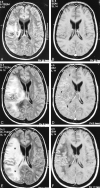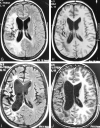Initial and follow-up MR imaging findings in AIDS-related progressive multifocal leukoencephalopathy treated with highly active antiretroviral therapy
- PMID: 11337345
- PMCID: PMC8174932
Initial and follow-up MR imaging findings in AIDS-related progressive multifocal leukoencephalopathy treated with highly active antiretroviral therapy
Abstract
Background and purpose: Recent studies have shown the beneficial effect of highly active antiretroviral therapy (HAART) in AIDS-related progressive multifocal leukoencephalopathy (PML). The purpose of our study was to evaluate the initial and follow-up imaging findings and survival in patients with PML who were treated with HAART.
Methods: The clinical course and MR imaging findings on initial and follow-up MR studies in four consecutive AIDS patients with PML who were treated with HAART are described.
Results: Two patients were short-term survivors and died after 3 months. Two patients are still alive, with a survival time of 22 and 43 months, respectively. On initial MR studies, more extensive white matter changes were seen in the short-term survivors. Development of a mass effect and temporary enhancement (in one patient) was observed in two HAART responders on follow-up MR studies. Increased hypointensity on T1-weighted images with concomitant low signal on fluid-attenuated inversion-recovery fast spin-echo (FLAIR-FSE) images was seen in two responders, representing leukomalacia. Atrophic changes of the involved areas of the brain, consistent with burnt out PML lesions, were seen in two long-term survivors. In the short-term survivors, increased hypointensity was present on T1-weighted images with increased high signal on FLAIR-FSE images, representing progressive destructive disease.
Conclusion: Our results suggest that a clinical and radiologic response can be seen in some patients with AIDS-associated PML on HAART while in others there may be no beneficial response. Development of a mass effect and temporary enhancement on MR images in the early phase of treatment might represent positive predictive factors for prolonged survival.
Figures



Similar articles
-
Follow-up magnetic resonance imaging findings in patients with progressive multifocal leukoencephalopathy: evaluation of long-term survivors under highly active antiretroviral therapy.Jpn J Radiol. 2009 Feb;27(2):69-77. doi: 10.1007/s11604-008-0302-3. Epub 2009 Mar 12. Jpn J Radiol. 2009. PMID: 19373535
-
Use of diffusion-weighted imaging to evaluate the initial response of progressive multifocal leukoencephalopathy to highly active antiretroviral therapy: early experience.AJNR Am J Neuroradiol. 2010 Jun;31(6):1031-5. doi: 10.3174/ajnr.A2024. Epub 2010 Apr 1. AJNR Am J Neuroradiol. 2010. PMID: 20360338 Free PMC article.
-
Progressive multifocal leukencephalopathy in patients on highly active antiretroviral therapy: survival and risk factors of death.J Acquir Immune Defic Syndr. 2004 Oct 1;37(2):1263-8. doi: 10.1097/01.qai.0000136093.47316.f3. J Acquir Immune Defic Syndr. 2004. PMID: 15385733
-
The effect of highly active antiretroviral therapy-induced immune reconstitution on development and outcome of progressive multifocal leukoencephalopathy: study of 43 cases with review of the literature.J Neurovirol. 2003;9 Suppl 1:73-80. doi: 10.1080/13550280390195351. J Neurovirol. 2003. PMID: 12709876 Review.
-
[Progressive multifocal leukoencephalopathy in AIDS].Ned Tijdschr Geneeskd. 1992 Mar 14;136(11):521-6. Ned Tijdschr Geneeskd. 1992. PMID: 1552955 Review. Dutch.
Cited by
-
Progressive multifocal leukoencephalopathy and other disorders caused by JC virus: clinical features and pathogenesis.Lancet Neurol. 2010 Apr;9(4):425-37. doi: 10.1016/S1474-4422(10)70040-5. Lancet Neurol. 2010. PMID: 20298966 Free PMC article. Review.
-
Natalizumab and progressive multifocal leucoencephalopathy.Ann Rheum Dis. 2006 Nov;65 Suppl 3(Suppl 3):iii48-53. doi: 10.1136/ard.2006.058404. Ann Rheum Dis. 2006. PMID: 17038473 Free PMC article. Review.
-
MRI imaging features of HIV-related central nervous system diseases: diagnosis by pattern recognition in daily practice.Jpn J Radiol. 2021 Nov;39(11):1023-1038. doi: 10.1007/s11604-021-01150-4. Epub 2021 Jun 14. Jpn J Radiol. 2021. PMID: 34125369 Free PMC article. Review.
-
The evolving face of human immunodeficiency virus-related progressive multifocal leukoencephalopathy: defining a consensus terminology.J Neurovirol. 2003;9 Suppl 1:88-92. doi: 10.1080/13550280390195298. J Neurovirol. 2003. PMID: 12709878 Review.
-
Brain biopsy in AIDS patients: diagnostic yield and treatment applications.AIDS Res Ther. 2014 Jan 21;11(1):4. doi: 10.1186/1742-6405-11-4. AIDS Res Ther. 2014. PMID: 24447375 Free PMC article.
References
-
- Berger JR, Concha M. Progressive multifocal leukoencephalopathy: the evolution of a disease once considered rare. Neurovirol 1995;1:5-18 - PubMed
-
- Happe S, Besselmann M, Matheja P, et al. Therapy of progressive multifocal leukoencephalopathy (PML) in AIDS with cidofovir (Vistide): review of the literature and two case reports. Nervenarzt 1999;70:935-943 - PubMed
-
- Portegies P, Algra PR, Hollak CEM, et al. Response to cytarabine in progressive multifocal leukoencephalopathy in AIDS. Lancet 1991;337:680-681 - PubMed
-
- Nicoli F, Chave B, Peragut JC, Gastaut JL. Efficacy of cytarabine in progressive multifocal leukoencephalopathy in AIDS. Lancet 1991;339:306 - PubMed
-
- De Luca A, Giancola ML, Cingolani A, et al. Clinical and virological monitoring during treatment with intrathecal cytarabine in patients with AIDS-associated progressive multifocal leukoencephalopathy. Clin Infect Dis 1999;28:624-628 - PubMed
MeSH terms
LinkOut - more resources
Full Text Sources
Medical
